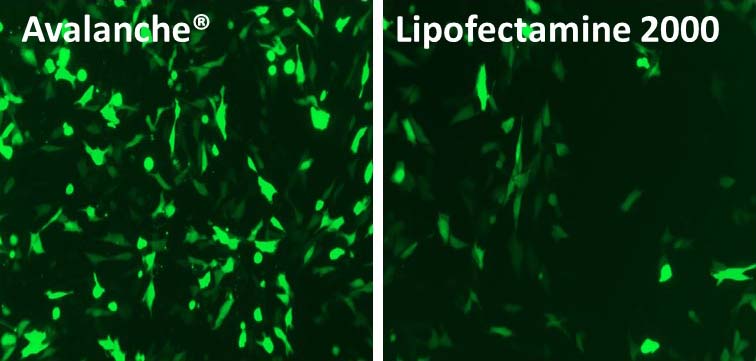Description
Cell to transfect:
Designations: C2C12
Cell Synonyms: CRL-1772
Organism: Mus musculus (mouse)
Strain: C3H
Tissue: muscle; myoblast
Morphology: myoblast
Growth Properties: adherent
Depositor: B. Paterson
C2C12 is a subclone (produced by H. Blau, et al) of the mouse myoblast cell line established by D. Yaffe and O. Saxel. This cell line differentiates rapidly, forming contractile myotubes and producing characteristic muscle proteins. Treatment with BMP-2 cause a shift in the differentiation pathway from myoblastic to osteoblastic.
Features of The Transfection Reagent:
- Broad spectrum for the transfection of large plasmid, mRNA, siRNA, and/or other type of nucleic acids, which is best for co-transfection of different type and/or size of nucleic acids.
- Unique formulation-maximize transfection performance in C2C12 cells.
- Lowest Cellular Toxicity-maintain cell density and reduce experimental biases
- 0.5 ml is able to transfect about 1000 wells of 24-well plate
- Deliver single or multiple plasmids
- Suitable for Reverse Transfection
- Reproducible: due to highly controlled chemical synthesis of each of the ingredients, the reagent forms uniformly sized complex particles with nucleic acids. With optimized protocol, our reagent will ensure the reproducible highest transfection results.
- Economical: High efficiency means less amount of nucleic acid & reagent is needed
- Developed and manufactured by EZ Biosystems
Data
 FIG. 1. High throughput test of transfection efficiency (determined as RLU/mg) on C2C12 cells after transfection of luciferase reporter gene by using our 172 proprietary transfection formulas and several most popular commercial transfection reagents. The yellow box showed the results of 4 commercial transfection reagents. The red lines marked our candidate formulas with the highest transfection efficiency for C2C12 cells. This test result was confirmed with repeat experiments. The one that showed the optimal balance of potent & low cytotoxicity among those candidate formulas after flow cytometry analysis on the percentage of 7AAD positive cells was later named as this C2C12 Cell Avalanche Transfection Reagent.
FIG. 1. High throughput test of transfection efficiency (determined as RLU/mg) on C2C12 cells after transfection of luciferase reporter gene by using our 172 proprietary transfection formulas and several most popular commercial transfection reagents. The yellow box showed the results of 4 commercial transfection reagents. The red lines marked our candidate formulas with the highest transfection efficiency for C2C12 cells. This test result was confirmed with repeat experiments. The one that showed the optimal balance of potent & low cytotoxicity among those candidate formulas after flow cytometry analysis on the percentage of 7AAD positive cells was later named as this C2C12 Cell Avalanche Transfection Reagent.
Results kindly provided by C Rhodes, Ph.D. NIH/NIDCR on C2C12 cells
For Other Cells
C2C12 Cell Avalanche® Transfection Reagent can also be used on the following cells with high transfection efficiencies.
H9c2(2-1)
L6 Cell
786-O Cell
Vero Cell
293 Cell
293T/17 Cell
Recommended protocols for these cells will be provided with the reagent. The protocols usually provide satisfactory transfection efficiency with invisible cytotoxicity. However, optimization may be needed for certain type of cells. Optimizations may include: the amount of DNA and this transfection reagent; cell density; transfection reagent/DNA ratio, or incubation time for the mixture of transfection reagent/DNA etc. For best transfection result, we recommend using the respective cell type/cell line specific Avalanche transfection reagents. Those reagents have been optimized on both recipes and protocols, and have been proved to have the best transfection results for the respective cell lines or primary cells. You can easily find the respective Avalanche transfection reagents specific for your cells by using the filters of our product list.
Additional Information
| Weight | 0.5 lbs |
|---|---|
| Adherence Phenotype | Adherent |
| Cell Type | Myoblast |
| Disease | Healthy |
| Names starting from | C |
| Primary/Cell Line | Cell Line |
| Product Sizes | 0.5 ml, 1.5 ml |
| Species | Mouse |
| Tissue Sources | Skeletal Muscle |
| Subcategories | Cell Type/Cell Line Specific |
Documents
Protocols
MSDS
Citations or Feedback
- Cocchiararo, I., Cornut, M., Soldati, H., Bonavoglia, A., & Castets, P. (2022). Back to basics: Optimization of DNA and RNA transfer in muscle cells using recent transfection reagents. Exp Cell Res, 421(2), 113392. doi:10.1016/j.yexcr.2022.113392



